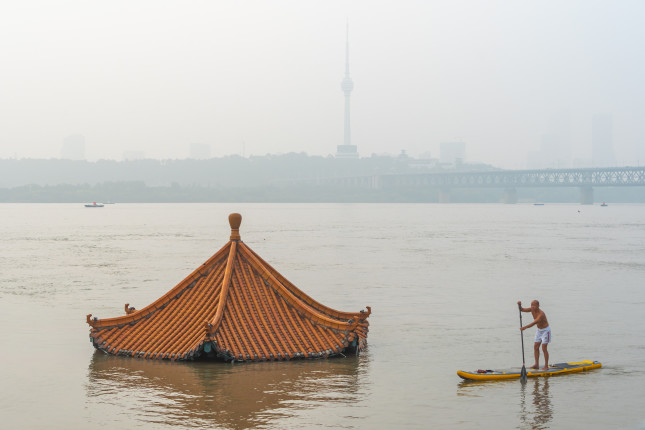-
China’s Climate Security Vulnerabilities
April 25, 2023 By Angus Soderberg
Climate change’s ripples reach every corner of the globe, but nowhere is their geopolitical impact more pronounced than in China’s relations with the United States. This is especially the case as the undisputed security risks posed to both nations by climate change become intertwined with broader arcs of political, economic, and military competition on both sides.
At the recent Wilson Center event on China’s vulnerability to climate change, ECSP Director Lauren Risi observed that “we are not just living in a time increasingly reshaped by climate change; we are in an era often referred to as ‘strategic competition,’ where China is considered a pacing challenge by the U.S. Department of Defense.”
Both the U.S. and China are acutely vulnerable to the impacts of climate change. Yet while the Chinese Communist Party (CCP) has been quick to identify climate change as a national security threat, it sees that challenge through the larger prism of strategic competition. “For Beijing’s leaders, the top threat comes from the global West, and in particular, the United States,” says Robert Daly, Director of the Kissinger Institute.
Climate change cannot be addressed without the cooperation of China, which remains the world’s largest greenhouse gas emitter. Yet the overall deterioration in relations between the United States and China makes understanding climate security risks essential. This knowledge can help U.S. policymakers identify potential opportunities and pitfalls that will define future areas of cooperation and competition.
Assessing the Threats
China boasts a number of vast and diverse landscapes. The challenges faced by each landscape are equally diverse, including heatwaves, melting glaciers, and flooding in its river deltas. In a report written late last year, Erin Sikorsky, Director at the Center for Climate and Security, outlined the three categories of climate threats faced by China. These include a direct risk to critical and military infrastructure, compounding risks to food and water security, and geopolitical risks in climate change’s potential to exacerbate tensions with China’s neighbors and create shifts in its regional relations.
While climate impacts reverberate throughout Chinese society, compromising agricultural yields, food security, and prompting migration, however, one threat is seen by its leaders as the most important. “Water is China’s biggest environmental, economic, and social problem,” said Jennifer Turner, Director of the China Environment Forum.
Solving the water crisis can even require overt military intervention, she added. The People’s Liberation Army is mobilized for disaster relief after severe weather events, like the 2022 drought.
Climate challenges also pose a real political threat to the CCP, observed Gregory Pollock, Principal Director for Arctic and Global Resilience Policy in the Office of the Secretary of Defense. As the compounding effects of climate change impose additional costs on Chinese society, he continued, “some Chinese may begin to wonder whether the Communist party, which doesn’t have the foundational legitimacy of democratically elected leadership, has lost the so-called Mandate of Heaven.”
China’s Response to Climate Risks
China has long practiced a “holistic view of security that comprised environmental factors,” Daly remarked. This can be observed in Chinese history all the way back to Yu the Great, a legendary emperor who united China by building out water infrastructure to control floods and natural disasters.
While this legacy is woven into the fabric of national consciousness, Sikorsky said that China’s modern approach to reducing climate security challenges largely mirrors the country’s approach to other major problems. Massive public works and infrastructure projects are one key element, while boosting disaster response mechanisms and restricting public dissent are also part of the equation.
Yet while it is true most major party policy and decision-making occurs from the top down, added Daly, it would be a mistake for observers not to acknowledge the presence of “grassroots pressure” in China for climate action.
China has implemented impressive policies such as its National Climate Change Adaptation Plan and national water consumption cap. Yet Sikorsky noted that despite the success of China’s multifaceted response in mitigating immediate impacts, “there is uncertainty regarding all of these responses.”
Some of this uncertainty is rooted in politics. For instance, there is a notable lack of policy feedback in an authoritarian system—a problem that hindered the effectiveness of China’s COVID-19 response and could limit its responses to climate disasters. “Where decision-making is concentrated, you see societies become brittle in the context of disaster,” said Pollock.
External politics are also an issue. It is increasingly difficult for China to maintain its relations with nations in the Global South when it refuses to engage in discussions about global climate finance and mitigation efforts. As Daly pointed out, China has the capacity to contribute much more than it currently does to international climate action.
This lack of global engagement is in part due to China’s lack of vision regarding global climate security. Sikorsky added that to the extent China possesses a global climate security vision, it involves policing “internal responses and instability” and exporting these policing methods to other countries.
The Competition Context
Climate security considerations are an important nontraditional security threat for China. Yet Daly stated that they are not an “existential threat,” and must be viewed against the backdrop of what China believes to be its true existential threat: the United States.
The broader context of competition makes it difficult for China and the U.S. to engage in any productive form of cooperation on climate change. From a security perspective, the impacts of sea-level rise on military infrastructure, or the need to divert greater attention away from building military power to address the impacts of climate change may create situations that favor the U.S. or China as circumstances develop.
In fact, both sides are likely to seek military, economic, or political advantages based on the other’s climate policies. For instance, Pollock suggested that China has embraced a delay on international climate action “perhaps to buy time for further fossil fuel-powered economic development.”
In theory, growing competition between China and the U.S. could lead to effective climate action, with the equivalent of an “arms race” as both countries vie to achieve a reduction in emissions. At present, however, there is little evidence to support this scenario. In fact, competition in the military-industrial complex “makes meaningful direct cooperation on combating climate change impossible,” said Daly.
Pollock also noted that this scenario depicting competition as a boon to climate efforts was not grounded in evidence. Other than the historic 2014 U.S.-China joint announcement on climate change, he continued, there have been no purposeful bilateral relations on climate issues, and competition between the two countries has only grown.
What Does This Mean for the U.S.?
China’s vulnerability to climate change presents opportunities for the U.S. to cooperate and compete. Yet Sikorsky observed that to accomplish either activity effectively, U.S. policymakers must obtain a greater understanding of China’s climate security risks in order to link them with their reverberating economic and socio-political consequences. She suggested that meeting these challenges requires a “whole of government China-climate security working group.”
Pollock pointed out another need: the U.S. must take proactive measures to galvanize diplomatic support for its role as the preeminent global climate ally, which will require a complex and nuanced foreign policy approach.
Sikorsky agreed, noting that increasing climate diplomacy and “prioritizing climate adaptation and resilience programs for Indo-Pacific allies” would signal the U.S.’s intention to be the “partner of choice in the region.” To do so, the United States must define its own global climate security narrative.
This effort also requires defining China as part of the problem, and promoting the message that the world is “going to bear the burden of China’s continued world-leading contributions to global warming,” said Pollock.
Yet cooperation in certain areas is also a possibility. Sikorsky pointed to importance of finding “opportunities to deepen the relationship” and seeking out cooperation. Indeed, the U.S. and China share a mutual interest in mitigating the impacts of climate change on global supply chains, regional instability, and transboundary challenges.
Turner also noted that there is an opportunity for U.S.-China cooperation on agriculture. At COP26 in Glasgow in 2021, she recalled, both countries agreed to work together on climate and agriculture, although little progress has come as of yet from these promises.
Understanding the dynamics of competition and cooperation resulting from China’s climate security vulnerabilities will be a consequential part of U.S. national security policy in the decades to come. As climate risks become increasingly interwoven with competition in U.S.-China relations, said Pollock, “it is the militaries and societies that best adapt to the changing strategic environment that will have the advantage in strategic competition.”
Sources: Council on Strategic Risk, The China Project, and The Center for Security and Emerging Technology.
Photo credit: Flooding along the Yangtze River in Wuhan, China, courtesy of sleepingpanda/shutterstock.com.
 A Publication of the Stimson Center.
A Publication of the Stimson Center.






